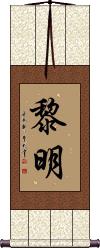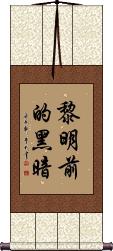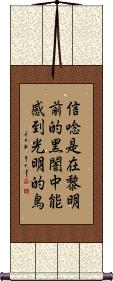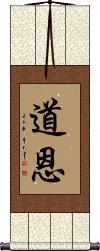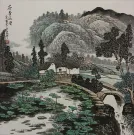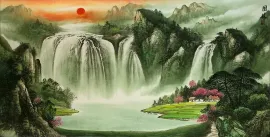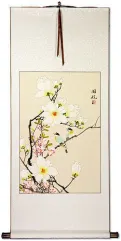Many custom options...
And formats...

Dawn in Chinese / Japanese...
Buy a Dawn calligraphy wall scroll here!
Personalize your custom “Dawn” project by clicking the button next to your favorite “Dawn” title below...
Dawn / Early Morning / Twilight
黎明 is the word that means dawn, early morning, or daybreak in Chinese, Japanese Kanji, and old Korean Hanja.
The Night is Darkest Before the Dawn
黎明前的黑暗 is the most natural way to write “The night is darkest before the dawn,” in Chinese.
The words break down this way by meaning this way:
1.黎明 dawn or daybreak
2.前 before, in front, ago, former, previous, and/or earlier
3.的 (possessive particle) of
4.黑暗 dark, darkly, or darkness
If you try to understand the Chinese word order and grammar, it's like, “Before dawn is the darkest [time].”
Faith is the bird that feels the light when the dawn is still dark
信唸是在黎明前的黑闇中能感到光明的鳥 is a philosophical poem/quote from Indian Poet and Philosopher, Rabindranath Tagore.
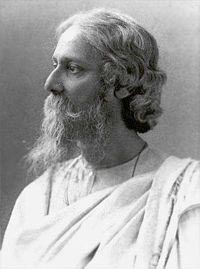
Rabindranath Tagore, 1915
This quote is not sourced, and therefore several variations exist in English. Some suggest the original was in the Bengali language.
This, of course, is the Chinese translation that has the meaning of, “Faith is the bird that feels the light and sings when the dawn is still dark.”
More about Rabindranath Tagore
Dawn
Dawn
This in-stock artwork might be what you are looking for, and ships right away...
Gallery Price: $200.00
Your Price: $128.88
Gallery Price: $120.00
Your Price: $79.88
Gallery Price: $120.00
Your Price: $49.88
Gallery Price: $120.00
Your Price: $49.88
These search terms might be related to Dawn:
Asahi / Morning Sun
Birth / Life
Birth Old-Age Sickness Death
Dawn / Early Morning / Twilight
Failure is the Origin of Success
Fresh Start
Genesis
Morning Dew
Morning Sun
New Beginning
Re-Birth / Renaissance
Resurrection / Re-Birth
Sunrise
Not the results for dawn that you were looking for?
Below are some entries from our dictionary that may match your dawn search...
| Characters If shown, 2nd row is Simp. Chinese |
Pronunciation Romanization |
Simple Dictionary Definition |
旭 see styles |
xù xu4 hsü noboru のぼる |
More info & calligraphy: Morning SunMcIntosh (apple); McIntosh red; (given name) Noboru |
菫 see styles |
jǐn jin3 chin sumire すみれ |
More info & calligraphy: Violet(kana only) violet (any flower of genus Viola, esp. the Fuji dawn, Viola mandshurica); (surname, female given name) Sumire |
黎明 see styles |
lí míng li2 ming2 li ming reimei / reme れいめい |
More info & calligraphy: Dawn / Early Morning / Twilight(1) daybreak; dawn; gray of the morning (grey); (2) dawn (of a new age); (female given name) Reimei |
黎明前的黑暗 see styles |
lí míng qián de hēi àn li2 ming2 qian2 de5 hei1 an4 li ming ch`ien te hei an li ming chien te hei an |
More info & calligraphy: The Night is Darkest Before the Dawn |
倝 see styles |
gàn gan4 kan |
dawn (archaic) |
旦 see styles |
dàn dan4 tan hajimu はじむ |
(literary) dawn; daybreak; dan, female role in Chinese opera (traditionally played by specialized male actors) (given name) Hajimu Dawn. |
旴 see styles |
xū xu1 hsü |
dawn |
昉 see styles |
fǎng fang3 fang |
dawn; to begin |
昒 see styles |
hū hu1 hu |
daybreak; dawn; dusky; dim |
昕 see styles |
xīn xin1 hsin |
dawn |
晗 see styles |
hán han2 han |
before daybreak; dawn about to break; (used in given names) |
晞 see styles |
xī xi1 hsi |
dawn; to dry in the sun |
晨 see styles |
chén chen2 ch`en chen hayashi はやし |
morning; dawn; daybreak (surname) Hayashi Dawn, morning. |
暁 see styles |
xiǎo xiao3 hsiao yutaka ゆたか |
Japanese variant of 曉|晓 (out-dated or obsolete kana usage) dawn; daybreak; (1) dawn; daybreak; (2) event (e.g. "in the event of ..."); occasion; occurrence; (personal name) Yutaka |
曉 晓 see styles |
xiǎo xiao3 hsiao shou / sho しょう |
dawn; daybreak; to know; to let sb know; to make explicit (out-dated kanji) (out-dated or obsolete kana usage) dawn; daybreak; (out-dated kanji) (1) dawn; daybreak; (2) event (e.g. "in the event of ..."); occasion; occurrence; (female given name) Shou Dawn, shining, clear; to know, to make known. |
曙 see styles |
shǔ shu3 shu sho しょ |
(bound form) daybreak; dawn; Taiwan pr. [shu4] dawn; daybreak; beginning; (given name) Sho |
曚 see styles |
méng meng2 meng |
twilight before dawn |
沬 see styles |
mèi mei4 mei |
dawn; place name |
一早 see styles |
yī zǎo yi1 zao3 i tsao kazusa かずさ |
early in the morning; at dawn (female given name) Kazusa |
三時 三时 see styles |
sān shí san1 shi2 san shih mitoki みとき |
(adverbial noun) (1) 3 o'clock; (2) 3 o'clock snack; (personal name) Mitoki The three divisions of the day, i.e. dawn, daylight, and sunset; or morning, noon, and evening; also the three periods, after his nirvāṇa, of every Buddha's teaching, viz., 正 correct, or the period of orthodoxy and vigour, 像 semblance, or the period of scholasticism, and 末 end, the period of decline and termination. |
今暁 see styles |
kongyou / kongyo こんぎょう |
(n,adv) this morning (at dawn) |
仏暁 see styles |
futsugyou / futsugyo ふつぎょう |
(irregular kanji usage) (n-adv,n-t) dawn; daybreak |
侵晨 see styles |
qīn chén qin1 chen2 ch`in ch`en chin chen |
towards dawn |
傍亮 see styles |
bàng liàng bang4 liang4 pang liang |
dawn; daybreak |
六時 六时 see styles |
liù shí liu4 shi2 liu shih rokuji ろくじ |
(1) six o'clock; (2) (Buddhist term) six periods of a day (morning, midday, afternoon, evening, midnight, late night) The six 'hours' or periods in a day, three for night and three for day, i. e. morning noon, evening; night, midnight, and dawn. Also, the six divisions of the year, two each of spring, summer, and winter. |
啟明 启明 see styles |
qǐ míng qi3 ming2 ch`i ming chi ming |
Classical Chinese name for planet Venus in the east before dawn |
嚆矢 see styles |
koushi / koshi こうし |
(1) (See 鏑矢) whistling arrow used to signal the start of battle; (2) start (e.g. of a movement); beginning; dawn |
地藏 see styles |
dì zàng di4 zang4 ti tsang jizou / jizo じぞう |
Kṣitigarbha, the Bodhisattva of the Great Vow (to save all souls before accepting Bodhi); also translated Earth Treasury, Earth Womb, or Earth Store Bodhisattva (surname) Jizou Ti-tsang, J. Jizō, Kṣitigarbha, 乞叉底蘗沙; Earth-store, Earth-treasury, or Earthwomb. One of the group of eight Dhvani- Bodhisattvas. With hints of a feminine origin, he is now the guardian of the earth. Though associated with Yama as overlord, and with the dead and the hells, his role is that of saviour. Depicted with the alarum staff with its six rings, he is accredited with power over the hells and is devoted to the saving of all creatures between the nirvana of Śākyamuni and the advent of Maitreya the fifth century he has been especially considered as the deliverer from the hells. His central place in China is at Chiu-hua-shan, forty li south-west of Ch'ing-yang in Anhui. In Japan he is also the protector of travellers by land and his image accordingly appears on the roads; bereaved parents put stones by his images to seek his aid in relieving the labours of their dead in the task of piling stones on the banks of the Buddhist Styx; he also helps women in labour. He is described as holding a place between the gods and men on the one hand and the hells on the other for saving all in distress; some say he is an incarnation of Yama. At dawn he sits immobile on the earth 地 and meditates on the myriads of its beings 藏. When represented as a monk, it may be through the influence of a Korean monk who is considered to be his incarnation, and who came to China in 653 and died in 728 at the age of 99 after residing at Chiu-hua-shan for seventy-five years: his body, not decaying, is said to have been gilded over and became an object of worship. Many have confused 眞羅 part of Korea with 暹羅 Siam. There are other developments of Ti-tsang, such as the 六地藏 Six Ti-tsang, i. e. severally converting or transforming those in the hells, pretas, animals, asuras, men, and the devas; these six Ti-tsang have different images and symbols. Ti-tsang has also six messengers 六使者: Yama for transforming those in hell; the pearl-holder for pretas; the strong one or animals; the devīof mercy for asuras; the devī of the treasure for human beings; one who has charge of the heavens for the devas. There is also the 延命地藏 Yanming Ti-tsang, who controls length of days and who is approached, as also may be P'u-hsien, for that Purpose; his two assistants are the Supervisors of good and evil 掌善 and 掌惡. Under another form, as 勝軍地藏 Ti-tsang is chiefly associated with the esoteric cult. The benefits derived from his worship are many, some say ten, others say twenty-eight. His vows are contained in the 地藏菩薩本願經. There is also the 大乘大集地藏十電經 tr. by Xuanzang in 10 juan in the seventh century, which probably influenced the spread of the Ti-tsang cult. |
夜明 see styles |
yoake よあけ |
(irregular okurigana usage) dawn; daybreak; (p,s,f) Yoake |
天明 see styles |
tiān míng tian1 ming2 t`ien ming tien ming tenmei / tenme てんめい |
dawn; daybreak (1) dawn; daybreak; (2) (hist) Tenmei era (1781.4.2-1789.1.25); (place-name, surname) Tenmei |
Click here for more dawn results from our dictionary
The following table may be helpful for those studying Chinese or Japanese...
| Title | Characters | Romaji (Romanized Japanese) | Various forms of Romanized Chinese | |
| Dawn Early Morning Twilight | 黎明 | rei mei / reimei | lí míng / li2 ming2 / li ming / liming | |
| The Night is Darkest Before the Dawn | 黎明前的黑暗 | lí míng qián de hēi àn li2 ming2 qian2 de hei1 an4 li ming qian de hei an limingqiandeheian | li ming ch`ien te hei an limingchienteheian li ming chien te hei an |
|
| Faith is the bird that feels the light when the dawn is still dark | 信唸是在黎明前的黑闇中能感到光明的鳥 信念是在黎明前的黑暗中能感到光明的鸟 | xìn niǎn shì zài lí míng qián de hēi àn zhōng néng gǎn dào guāng míng de niǎo xin4 nian3 shi4 zai4 li2 ming2 qian2 de hei1 an4 zhong1 neng2 gan3 dao4 guang1 ming2 de niao3 xin nian shi zai li ming qian de hei an zhong neng gan dao guang ming de niao | hsin nien shih tsai li ming ch`ien te hei an chung neng kan tao kuang ming te niao hsin nien shih tsai li ming chien te hei an chung neng kan tao kuang ming te niao |
|
| Dawn | 道恩 | dào ēn / dao4 en1 / dao en / daoen | tao en / taoen | |
| Dawn | ドーン | doon / don | ||
| In some entries above you will see that characters have different versions above and below a line. In these cases, the characters above the line are Traditional Chinese, while the ones below are Simplified Chinese. | ||||
Successful Chinese Character and Japanese Kanji calligraphy searches within the last few hours...
